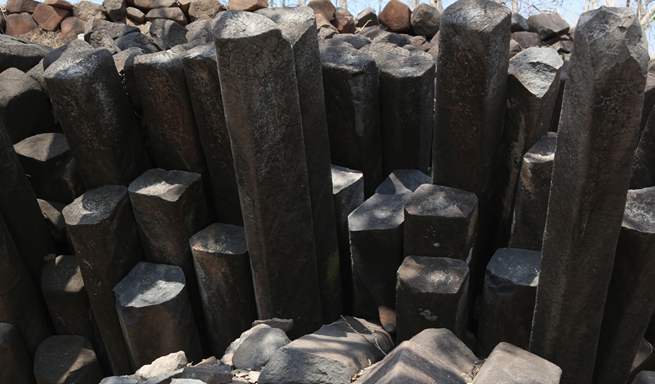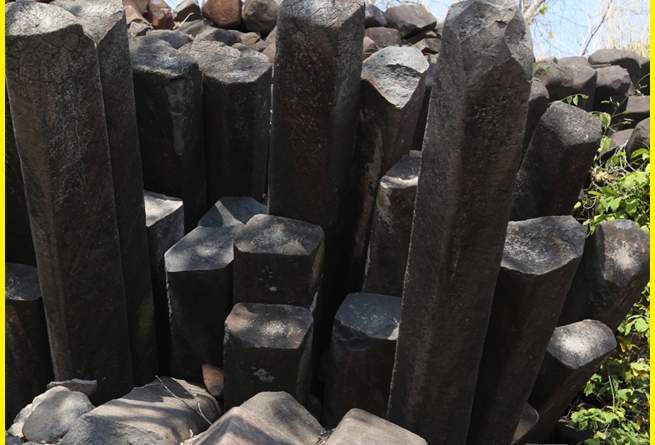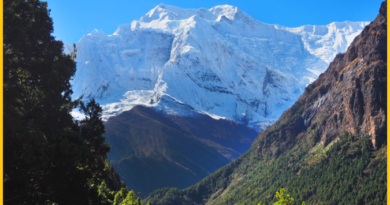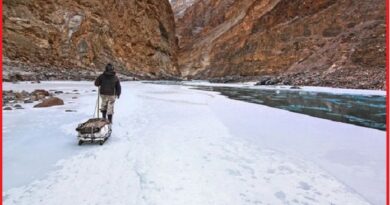Geological Wonders-The Marvel of Kavadia Hill’s Columnar Joints
Columnar joints, Kavadia Pahad Dewas
Columnar joints, Kavadia Hill Dewas are a geological formation characterized by closely spaced, vertical, polygonal columns that develop in igneous rocks, typically basalt, as a result of cooling and contraction. These amazingly stacked, horizontal to sub-horizontal polygonal columns of basalt developed during the cooling of magma.
These hills are made of polygon-shaped rock pillars which are of various shapes triangular, rectangular, pentagonal, and hexagonal. There are seven hills of the same type. It appears that these stones are man-made because they appear to be minutely carved by human beings, but in reality, it is a creation of Volcano eruption. It may be very well considered as the eighth wonder of the World. On striking these stone pillars sounds like metal pillars. According to Hindu mythology, it is considered that during the Mahabharat period, these structures were created by the “Great Bheem” to check the way of river Narmada to fulfill a vow within a day, but Bheem could not do it and since then these stones pillars are lying there.
Geology Kavadia Hill
Kavadia Hill is formed with the finest interlocking basalt columns and it gives the appearance of a manmade structure. Most of the columns are hexagonal and interlocked with joint rocks. All visible columns are mostly 4 to 5 meters long but there could be longer rocks further deep inside. these rock formations are spread over six sites on the mountain. The presence of basaltic columns is unique and is found in several places around the world. The quantity, geometrical arrangement, and location (long away from the ocean) of this place are unique and of geographical importance.
These types of Columnar joints form when lava or magma cools and contracts, causing it to crack into polygonal columns. The columns are usually hexagonal, but can also be pentagonal, octagonal, or other shapes depending on various factors like cooling rate and chemical composition of the magma.

These geological formations are often visually striking and can be found in various parts of the world where volcanic activity has occurred. Some well-known examples include the Giant’s Causeway in Northern Ireland, the Devil’s Postpile in California, and the Organ Pipes in Namibia.
If Kavadia Hill in Dewas indeed features columnar joints, it would likely be a site of geological and scenic interest, attracting visitors and researchers alike to study and admire this fascinating natural phenomenon.
Also, Read- Geotourism around Magnificent Patalpani Waterfall and its Surrounding Place
Geotourism
The Kavadia hill is exposed in the form of seven detached linear ridges, trending ENE–WSW over a distance of 4.5 km, having an average width of 80 m and exposed at 36 to 51 m above the general ground level. The in situ columns in the dyke-ridges that have so far been observed show straight, parallel faces without any striations. The length of the columns ranges between 1 and 5 m. The columns that are inclined and penetrated deep inside may have greater lengths. Each ridge consists of perfectly separate, very well-developed, finely stacked, and interlocked, horizontal columnar joints that are inclined at various degrees. The columns are polygonal in shape, and the majority show tetragon, pentagon, and hexagon shapes with hexagons can also be seen.
The Basalt column in Kawadia Pahad is rare from the geological point of view and could be developed and promoted as a new Geotourism destination in India. The Columnar joints are picturesque and the arrangement of the columns is magnificent that could not be anywhere else.
How to Reach Kavadia Hill
The nearest airport to Kavadia Hill is situated at Indore is about 40 K.M. away from Dewas. Domestic air carriers like Indian airlines and private airlines connect Indore to Delhi, Mumbai, Chennai, Kolkata, and all major cities. Dewas is well connected by good train services to Delhi, Mumbai, Calcutta, Madras, Jaipur, and all major cities. After reaching Dewas one can easily find Bagli town near Dharaji. From Bagli the site is 10 km away.



